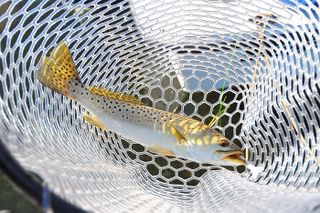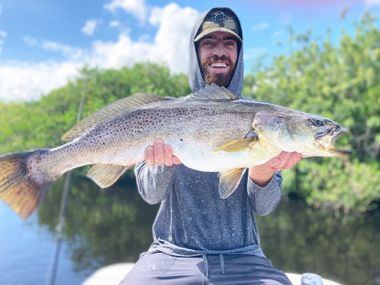Spotted Seatrout
The spotted seatrout (Cynoscion nebulosus), also known as speckled trout, is a common estuarine fish found in the southern United States along coasts of Gulf of Mexico and the coastal Atlantic Ocean from Maryland to Florida. While most of these fish are caught on shallow, grassy flats, spotted seatrout reside in virtually any inshore waters, from the surf of outside islands to far up coastal rivers, where they often come for shelter during cold weather. Contrary to its name, the spotted seatrout is not a member of the trout family (Salmonidae), but of the drum family (Sciaenidae). It is popular for commercial and especially recreational fishing in coastal waters of the southeastern United States. Adults reach 19-37 inches in length and 3-17 pounds in weight.
Distribution
Spotted seatrout live in the top of the water column and are most numerous along the coasts of the southeastern states, such as Texas, Louisiana, Alabama, Mississippi, Georgia, and Florida. They are also common along the coasts of North and South Carolina and Virginia. Estuarine coasts are prime settlement areas. They are uncommonly seen north of Delaware Bay and along the coast of Cape Cod, Massachusetts.
Characteristics
Spotted seatrout is the common name endorsed by the American Fisheries Society. However, this fish has many other common names, including speckled trout, speck, speckles, spec, truite gris (Louisiana French), trucha de mar (Mexican Spanish), spotted weakfish, spotted seateague, southern seateague, salmon, salmon trout, simon trout, winter trout, seatrout, Nosferatu fish, and black trout. Particularly large ones are nicknamed gator trout.
The spotted seatrout has prominent canine teeth. Like other fish of the family Sciaenidae, it has an elongated, soft dorsal fin with scales; it is separated from the spinous dorsal fin by a deep notch. It usually has two anal spines and the lateral line extends to the tip of the caudal fin. The back has distinct spots scattered on it, including on the dorsal and caudal fins. Unlike some other members of the family Sciaenidae, the spotted seatrout does not have any chin barbels. In stained water, this fish's background may take on a golden hue. Its shape and coloration is reminiscent of a brown trout. This fish is closely related to the weakfish, Cynoscion regalis.
The average size of spotted seatrout is 0.5-1.0 kg (1-2 lb), but in most areas fish up to 2.5 kg (5 lb) are fairly common. Fish weighing 3.5-4.5 kg (8-10 lb) are rare. The world record is 7.9 kg (17 lb 7 oz).
Food
Small trout eat large amounts of shrimp and other crustaceans. As they grow larger, their diets shift toward fish, the larger, the better. Studies in Texas and Mississippi show that really big trout strongly prefer to feed on mullet; a large trout will find the largest mullet it can handle and try to swallow it. Often the mullet is half or two-thirds as large as the trout.
Reproduction and growth
Like all members of the drum family, mature males make a "drumming" sound to attract females during the spawning season. Spotted seatrout have a long spawning season from spring through summer.
Larval seatrout reach 5–7 mm in length about two weeks after hatching, and 170–200 mm within about seven months. It takes between one and two years for seatrout to reach 300 mm (about 12 inches) and between two and three years to reach 400 mm in length (about 16 inches). The maximum age of spotted seatrout that have been caught is estimated to be 12 years old, though that is rare, and the oldest fish caught on a regular basis are closer to four or five years old.
By the end of the first year, spotted seatrout are about 250 mm long and about half of them are mature enough to reproduce. They reproduce in shallow, grassy areas of estuaries.
Management
The management of the species is limited to size and possession limits, but programs have been initiated to gather more information on their overall health and abundance.
Fishing
While spotted seatrout are caught by both commercial and recreational fishermen, recreational fishing represents the vast majority of the catch. Almost all spotted seatrout are caught with hook and line, as many places have banned fishing for them with gillnets.
According to the NOAA, spotted seatrout are in the top ten species for recreational fishing in the United States. From 1993 – 2003, recreational fishermen in Louisiana harvested more than 6 million spotted seatrout each year. Along the coasts of North Carolina and Virginia, more than half a million speckled trout were caught by recreational fishermen each year between 2005 and 2008. Nevertheless, because they reproduce so well, spotted seatrout is listed as a “best choice” for sustainable seafood in Louisiana and Florida by the Monterey Bay Aquarium's Seafood Watch.
Free-line live shrimp or small pinfish or pigfish (grunts) near the bottom to entice trout out of grass-bed holes. Attaching a float will allow these baits to drift over the grass beds as you search for trout. Casting with soft-bodied jigs, top-water poppers and spoons can be effective. Trout are very delicate, so returning unwanted or illegal fish promptly to the water is necessary to maintain a healthy population.[1]
Gator Trout
This gorgeous Gator Trout is a BOFFF (big old fat fecund female).
A BOFFF is a highly valued member of the population as they can produce the majority of eggs in a population, have higher quality eggs, and their eggs have more successful hatch rates.
Trout typically spawn March-October with two spawning peaks, the strongest one in early June and a weaker one in late August. Trout are multiple batch spawners, meaning within a spawning season individuals spawn many times. The BOFFFs have the potential to spawn more frequently and more effectively along with having significantly higher egg production compared to their younger, smaller counterparts.
This fish was 37”, caught on the Indian River and successfully released back into the water which is always a great choice for conserving a valued fish and fishery. Recreational fishery landings for trout are high skewed toward females with females being 80% of the total catch in all Florida bays from 2002-2016.[2]
- ↑ "FWC Species Profile - Spotted seatrout". Retrieved 2021-11-10.
- ↑ FWC Fish and Wildlife Research Institute Facebook




